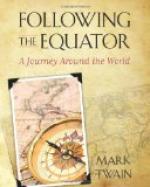Before I saw Australia I had never heard of the “weet-weet” at all. I met but few men who had seen it thrown—at least I met but few who mentioned having seen it thrown. Roughly described, it is a fat wooden cigar with its butt-end fastened to a flexible twig. The whole thing is only a couple of feet long, and weighs less than two ounces. This feather—so to call it—is not thrown through the air, but is flung with an underhanded throw and made to strike the ground a little way in front of the thrower; then it glances and makes a long skip; glances again, skips again, and again and again, like the flat stone which a boy sends skating over the water. The water is smooth, and the stone has a good chance; so a strong man may make it travel fifty or seventy-five yards; but the weet-weet has no such good chance, for it strikes sand, grass, and earth in its course. Yet an expert aboriginal has sent it a measured distance of two hundred and twenty yards. It would have gone even further but it encountered rank ferns and underwood on its passage and they damaged its speed. Two hundred and twenty yards; and so weightless a toy—a mouse on the end of a bit of wire, in effect; and not sailing through the accommodating air, but encountering grass and sand and stuff at every jump. It looks wholly impossible; but Mr. Brough Smyth saw the feat and did the measuring, and set down the facts in his book about aboriginal life, which he wrote by command of the Victorian Government.
What is the secret of the feat? No one explains. It cannot be physical strength, for that could not drive such a feather-weight any distance. It must be art. But no one explains what the art of it is; nor how it gets around that law of nature which says you shall not throw any two-ounce thing 220 yards, either through the air or bumping along the ground. Rev. J. G. Woods says:
“The distance to which the weet-weet or kangaroo-rat can be thrown is truly astonishing. I have seen an Australian stand at one side of Kennington Oval and throw the kangaroo rat completely across it.” (Width of Kensington Oval not stated.) “It darts through the air with the sharp and menacing hiss of a rifle-ball, its greatest height from the ground being some seven or eight feet . . . . . . When properly thrown it looks just like a living animal leaping along . . . . . . Its movements have a wonderful resemblance to the long leaps of a kangaroo-rat fleeing in alarm, with its long tail trailing behind it.”
The Old Settler said that he had seen distances made by the weet-weet, in the early days, which almost convinced him that it was as extraordinary an instrument as the boomerang.
There must have been a large distribution of acuteness among those naked skinny aboriginals, or they couldn’t have been such unapproachable trackers and boomerangers and weet-weeters. It must have been race-aversion that put upon them a good deal of the low-rate intellectual reputation which they bear and have borne this long time in the world’s estimate of them.




